
Caproni, also known as Società de Agostini e Caproni and Società Caproni e Comitti, was an Italian aircraft manufacturer. Its main base of operations was at Taliedo, near Linate Airport, on the outskirts of Milan.

The Caproni Ca.60 Transaereo, often referred to as the Noviplano (nine-wing) or Capronissimo, was the prototype of a large nine-wing flying boat intended to become a 100-passenger transatlantic airliner. It featured eight engines and three sets of triple wings.
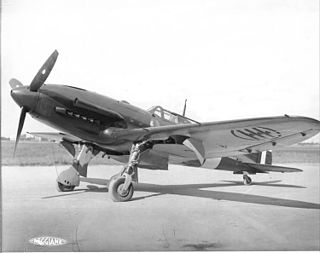
The Reggiane Re.2005 Sagittario was an Italian monoplane fighter and fighter-bomber produced for the Regia Aeronautica during the later years of World War II. Along with the Macchi C.202/C.205 and Fiat G.55, the Reggiane Re.2005 was one of the three Serie 5 Italian fighters. The lines of the fuselage were aerodynamically efficient, and the design was intended to exploit the famous Daimler-Benz DB 605 engine. The only drawback was a certain structural weakness in the rear section of the fuselage. Only 48 examples had been delivered before the Armistice, and these fighters took part in the defence of Naples, Rome and Sicily, with the survivors battling above the crumbling ruins of Berlin, in German insignia. British ace and military observer, Group Captain Duncan Smith, DSO DFC, said that "The Re.2005 was altogether a superb, potent aeroplane".
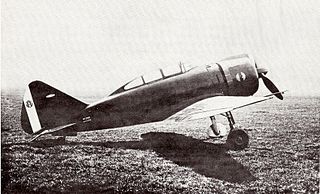
The Reggiane Re.2000 Falco I was an Italian all metal, low-wing monoplane developed and manufactured by aircraft company Reggiane. The type was used by the Regia Aeronautica and the Swedish Air Force during the first part of the Second World War.
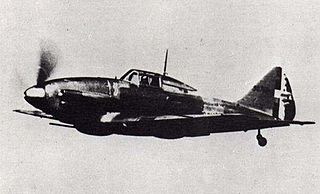
The Reggiane Re.2001 Falco II was an Italian fighter aircraft, serving in the Regia Aeronautica during World War II. A contemporary of the renowned Macchi C.202, the production of this type was to be limited to only 252, but it was a flexible design that proved to be able to undertake a number of roles. Thanks to its maneuverability it could dogfight with more powerful opponents like the Supermarine Spitfire. The Re.2001 became the basis of a later, more formidable fighter, the Re.2005.
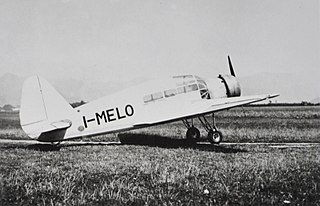
The Caproni PS.1, also known as the Pallavicino PS-1 and Caproni Ca.303, was an Italian four-seater sportsplane, designed and built specifically to compete in Challenge 1934, the European touring plane championships.
Officine Meccaniche Reggiane SpA was an Italian industrial manufacturer and aviation company.

The Reggiane Re.2002 Ariete ("Ram") was an Italian fighter-bomber developed during World War II. The aircraft was a further development of the Re.2000, with some of the modifications that already had been introduced in the Re.2001. The aircraft was mainly used by the Regia Aeronautica, but it also saw limited use with the German Luftwaffe, who used it against the French resistance.
The Piaggio P.32 was an Italian medium bomber of the late 1930s, produced by Piaggio, and designed by Giovanni Pegna. It was a modern design for its time, but was a failure due to lack of powerplants commensurate with its high wing loading.

The Reggiane Re.2003 was a development from the Reggiane Re.2002 fighter bomber that first flew on 29 June 1941. It was designed to replace the outdated IMAM Ro.37 used at the time. Unlike the Reggaine Re.2002, it had room for a second crewman who sat behind the pilot. It was equipped with onboard camera equipment. The Fiat A.74 RC.38 engine was intended to be used originally, but the Piaggio P. XI RC 40 Bis was chosen instead. Only one was ever produced, and production for a second started, but never finished. The Regia Aeronautica made an order of 200, but cancelled the order as Allied bombing raids made the Air Force's focus switch to fighter aircraft.
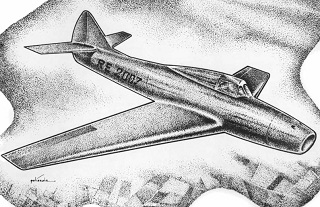
The Reggiane Re.2007 was a purported Italian fighter aircraft concept designed in 1943 by Roberto Longhi.

The Caproni Vizzola F.6 was a World War II-era Italian fighter aircraft built by Caproni. It was a single-seat, low-wing cantilever monoplane with retractable landing gear. Only two prototypes were built, one designated F.6M and the other designated F.6Z.

Giovanni Battista Caproni, 1st Count of Taliedo, known as "Gianni" Caproni, was an Italian aeronautical engineer, civil engineer, electrical engineer, and aircraft designer who founded the Caproni aircraft-manufacturing company.

The Reggiane Re.2004 was an Italian single-engined monoplane made by Reggiane and designed by Roberto Longhi. The aircraft never passed the preliminary stages.

The Caproni Ca.193 was an Italian liaison and air-taxi aircraft that was offered to the Italian Air Force as an instrument flight trainer and to the Navy for liaison. Design work started in 1945 and only the prototype was built. It was the last aircraft the Caproni company designed and built in Milan.

The Reggiane Re.2006 was an Italian fighter aircraft, of which only one prototype was built.
Giovanni Pegna was an important figure in the development of Italian aviation. He was the head of the construction department of Piaggio and later of the Officine Meccaniche Reggiane, a subdivision of Caproni.

The Isotta Fraschini Zeta was an air cooled X engine with 24 cylinders developed by the Italian engineering company Isotta Fraschini in the 1940s. It was developed as an indigenous alternative to the imported Daimler-Benz DB 605 that was being built under licence as the Fiat RA.1050 R.C.58 Tifone. The engine was essentially two Gamma V12 engines on a single crankshaft, but proved troublesome to develop and never entered production.

The Caproni Ca.7 was a proposed biplane designed by Caproni in the early 1910s.

The Caproni Ca.53 was an Italian prototype light bomber built in the last months of World War I.


















